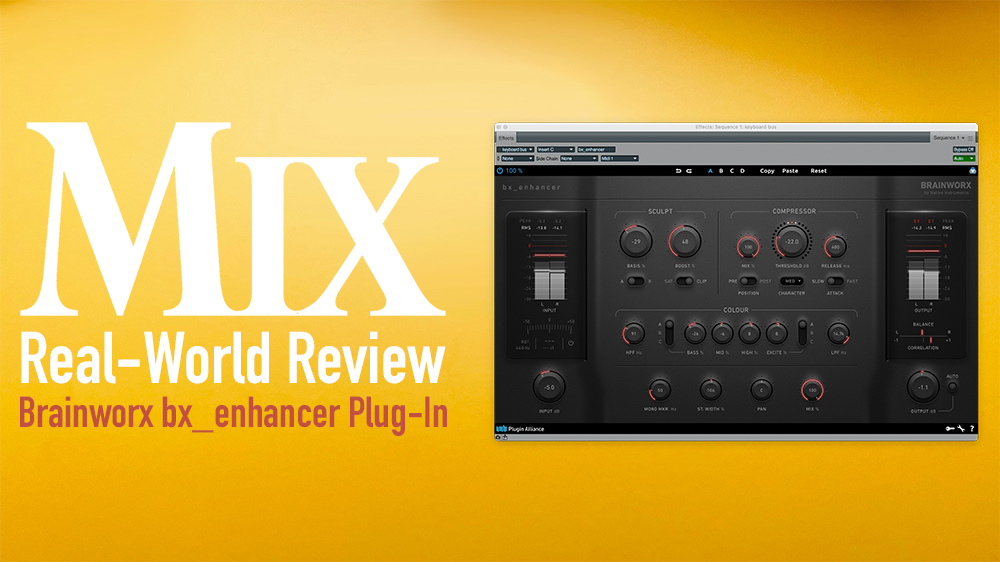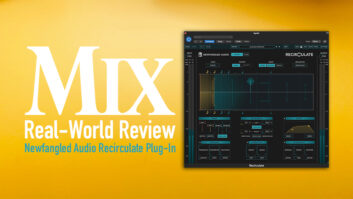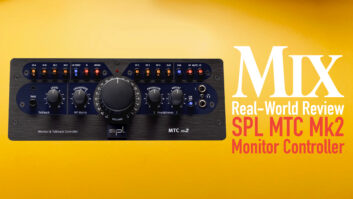
| MIX VERDICT: BRAINWORX BX_ENHANCER |
| THE TAKEAWAY: “It’s a powerful and handy plug-in that will appeal to both newbies and experienced studio users.” |
| COMPANY: Brainworx (Plugin Alliance) • www.pluginalliance.com PRICE: $89.99 (introductory), $149 (list) PROS: • Full-featured channel adjustment tools. • Compressor has three modes. • Tuner offers above-average stability. CONS: • Limited adjustability on EQ bands. |
Improving the sound of any source, whether an individual track or bus, is the modus operandi of the Brainworx bx_enhancer.
Its one-window, easily navigable GUI is divided into sections. On the far left is the Input, which includes an Input level knob, an Input meter showing RMS and Peak readings, and a Tuner. I’m not usually fond of tuners in software apps because they’re generally too jittery, making them hard to use. However, this one is quite stable. It is beneficial not only for guitarists, bassists and other stringed instrument players, but also for tuning vintage synths.
The next section to the right is called Sculpt, and it’s here that you can adjust the overall frequency spectrum using the Basis knob, which toggles between being a Tilt Filter and a boost/cut for midrange. Depending on the setting of the A/B switch, the Boost knob either adds mixer-style saturation or controls a Clipper function for harmonic distortion. The Clipper, especially, is great for adding excitement to a track.
The Compressor section contains Mix, Threshold and Release knobs, a three-way Character selector that controls the intensity of the analogmodeled compression, a Slow/Fast attack switch and a Pre/Post position switch. The Compressor offers plenty of versatility and solid sound quality.
Next is the Colour section (Brainworx uses the British spelling), which provides EQ and filtering. It includes Low-Pass and High-Pass filters, a Bass knob offering three different filter curves, fixed Mid and High bands and an Exciter. The latter also provides three different curves that you can experiment with.
Mixland Vac Attack — A Mix Real-World Review
Brainworx did a good job choosing frequencies for the EQ bands, but if you need to zero in on narrow regions, you may need to insert a dedicated EQ before or after bx_enhancer.
On a stereo instance of bx_enhancer, you’ll find knobs for several image-related parameters. They include Stereo Width, Mono Maker (for keeping frequencies under a user-adjustable setting in mono), Pan and Mix.
Be careful not turn the Stereo Width control too far or you may reduce the mono-compatibility of the signal. Fortunately, Brainworx included meters for Correlation and Balance just under the Output level meter.
Next to the Output knob is a button labeled Auto Level. If you turn it on, it gain-matches the processed output signal with the input. That makes it easy to accurately compare your track with the plug-in on and bypassed, avoiding the “louder is better” effect.
I found bx_enhancer useful for improving the sound of any track I inserted it on, including bass, electric guitar, acoustic guitar, drums, keyboards, vocals and more. I do wish the EQ was more adjustable, but on balance, it’s a powerful and handy plug-in that will appeal to both newbies and experienced studio users.
If you already have a compressor and EQ (or a channel strip) that you use regularly, you might assume that bx_enhancer is redundant.
However, you’ll still benefit from its saturation and clipper functions, and its stereo utilities. It’s definitely worth a tryout.







